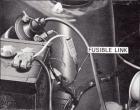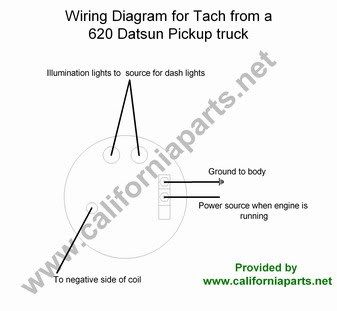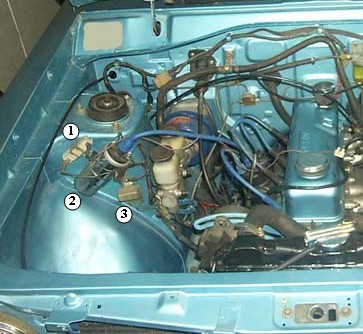| Revision as of 22:35, 23 June 2011 ddgonzal (Talk | contribs) (->Dash Lights) <- Previous diff |
Revision as of 18:45, 19 July 2011 ddgonzal (Talk | contribs) (->Clock) Next diff -> |
||
| Line 98: | Line 98: | ||
| = Clock = | = Clock = | ||
| - | [http://datsun1200.com/modules/myalbum/photo.php?lid=13939 http://datsun1200.com/modules/myalbum/photos/thumbs/13939.jpg] | + | See [[Clock#Wiring]] |
| - | The clock has a third wire, which goes to the Red/Black wire hanging down from the harness. This is the constant-Hot wire. If you wire to IGN, it only runs when the key is on :-) | + | http://datsun1200.com/modules/myalbum/photos/thumbs/13939.jpg http://datsun1200.com/modules/myalbum/photos/thumbs/13937.jpg http://datsun1200.com/modules/myalbum/photos/thumbs/13938.jpg |
| - | + | ||
| - | [http://datsun1200.com/modules/myalbum/photo.php?lid=13937 http://datsun1200.com/modules/myalbum/photos/thumbs/13937.jpg] [http://datsun1200.com/modules/myalbum/photo.php?lid=13938 http://datsun1200.com/modules/myalbum/photos/thumbs/13938.jpg] | + | |
| = Headlights = | = Headlights = | ||
Revision as of 18:45, 19 July 2011
Datsun 1200 wiring is relatively uncomplicated.
WARNING: Wire colors can vary by year, model and country. Please double-check the wiring in your Datsun 1200 before connecting parts according to this article. You don't want to burn something up! Use a voltmeter or test light to confirm the circuit behavior.
Also see: Wiring Diagram
Contents |
Wire color codes
| Code | Color |
| B | Black |
| W | White |
| R | Red |
| Y | Yellow |
| G | Green |
| L | Blue |
BW - Black wire with White stripe
Battery & Main Wiring
Battery has two wires, of course:
- Positive (+). Stock cable is RED. This connects directly to the starter's large connector. A smaller wire runs bout six inches from the terminal to the Fusible Link. See below.
- Negative (-, aka earth/ground). Stock cable is BLACK with Yellow stripe. It connects directly to the engine block at the oil pump. The engine end of this cable also has a smaller black wire. This is the main body ground and connects to the body at the Horn bolt
Main Wiring
There are three important main wires:
- Main ground wire (big battery cable). This bolts to the engine timing cover
- Body ground wire. This goes from the engine end of the Negative battery cable to the body. It's bolted down at the horn bolt. Without this weird problems can happen.
- Red wire at battery '+' terminal. This connects to the Fusible Link]] ("Main Fuse") about six inches from the battery
WARNING: Do not replace fusible link with a solid wire, or you risk burning up the entire wiring system ... If the fuse blows, figure out why before replacing it. Was there a short in the system, or did it simply overheat due to corroded contacts?
Make sure they cables are not damaged, and that they are securely fastened. If they are loose, remove and carefully inspect for corrosion. Clean thoroughly if possible, replace if neccesary. This original system will fully support all stock electrical loads.
Fusible Link
This goes between the battery and the main wiring harness (which also feeds the Alternator output "A" terminal)

See main article: Fusible Link
Fuse Box
In addition to the main fuse wire in the engine compartment, there is a main fuse box under the dashboard.
See main article: Fuse Box

Improvements
- Relocating battery to back of car. Advantages:
- Make room in engine compartment
- Balance weight of car
- 1200s are nose-heavy, so moving the 28-40 lb battery to the back helps. You need heavy-gauge cable, larger than stock due to the long lenght. Buy a kit with a sealed box, so fumes don't enter car
- Installing a modern new-fangled ground wire "System". There are two opinions:
AFRacer:
The grounding wire kits that people are putting on newer cars DO help out, and in many cases add power! I was a nonbeliever at first until I saw them used and they did add power and when I tore apart my 180SX I understood why it would add power. There are LOTS of electrical parts on newer cars, especially with EFI and distributorless ignitions ...
read moreddgonzal:
You've seen the ads where you install many grounds wires all over the car, sometimes using 'gold' connectors. They don't add horsepower. Not even new cars use this. There are advantages: They do make troubleshooting extremly complex wiring (like in a Mercedes with 47 computers) easier. My advice is don't waste your money on this.[edit:] After reading AFRacer's report above, I wonder if the B110 simply needs a better ground wire. The unibody is a large conductor so there is no problem there, but the stock ground wire is 1) kinda small and 2) in a place where corrosion can cause problems. Try using a thicker wire, grounding the battery and engine to the unibody in a better way (use a thick wire and good connections).
</blockquote>
Ignition Switch
The ignition switch bolts to the back of the key cylinder. There is a rectangular wire connector attached to it.
Alternator & Regulator
Our Datsun B110 used -- as with most 1964-1974 cars -- an Alternator with external Voltage regulator.
Alternator Connections
| terminal | Color | Logical Connections |
| A (Alternator) | WR or W | * To Battery + terminal through Fusible Link * To Regulator "A" terminal (W wire) |
| F (Field) | WB | * To Regulator "F" terminal |
| N (neutral point) | Y | * To Regulator "N" terminal * To electric choke relay Y wire |
| E (Earth/ground) | B | * To body ground * To Regulator "E" terminal |
Regulator Connections
| terminal | Color | Logical Connections |
| A (Alternator) | W | * To Alternator "A" terminal (WR or W) |
| F (Field) | WB | * To Alternator "F" terminal |
| N (nuetral point) | Y | * To Alternator "N" terminal * To electric choke relay Y wire |
| E (Earth) | B | * To body ground * To Alternator "E" terminal |
| IG (ignition) | WL (72: W?) | * To fuse box "M" terminal (fused through to IG terminal of ignition switch) |
| L (Light) | WR | * To dash light "IGN" ('72, '73) or "CHG" (1971) |
How the Alternator Dash Light Works
The dash lamp is connected to IGN +. The other side goes to the "L" terminal of the external regulator.
- When the alternator is not putting out current, the "L" terminal is at '-' voltage, so the dash light turns on
- Once the alternator starts putting out current, the "L" terminal is at + voltage, so the light turns off (both sides of the light are at +)
Alternator Upgrade
Many different Datsun alternators and alternators from other makes can easily be fitted to the Datsun 1200.
See main article: Alternator Upgrades
Clock
See Clock#Wiring



Headlights
See Headlight Wiring
Running Lights, Turn Signals, etc
See Lamp Wiring
Tachometer
There are two popular kinds of tachometers, using different wiring
- Induction wiring. There is no actual physical connection of the tachometer to the signal wires. This is what Datsun uses.
- Voltage signal wiring. The tachometer wire is connected to the '-' terminal of the coil (e.g. to the points). This is what most aftermarket tachometers use. Simply wire this in without changing/cutting the existing wiring.
Factory Tachometer
The factory Datsun 1200 tachometer is wired differently than most tachos because it uses induction signal.
- B - ground - to back of Instrument Cluster
- YR - IG power - to back of Instrument Cluster
- RG - lights (two lights, two wires. Not shown in photo above) to back of Instrument Cluster
- BW (Black with White stripe) - signal loop - to BW wires in dash harness
Conceptually the Induction LOOP works like this:

The BW loop of wire is the current induction coil. The ends of the loop, logically speaking, go in between the IG terminal of the ignition switch and the single-terminal (non-coil) side of the Ballast Resistor. Note that all IGN current goes through this wire, so connect it up in series using the factory connectors (yes, even cars without tachometer have the wiring in place). This is a BW wire along the top of the instrument cluster, seen here inside the yellow circle:

Pull the BW dash harness wires apart at the connectors, and plug them into the BW loop of the tachometer.
On the back of the instrument cluster circuit board -- marked as #1 in the photo above -- are three terminals on the back of the speedometer, just below the left turn signal indicator connector. From top to bottom:
- Lights - RG connect to male spade connector
- Ground - B connect to round flat slide-on connector
- IG power - connect to round bullet connector
This applies to the Round Gauge dash. The square type has only the Light connector, but a tach can be grounded to one of the gauge housing screws.
NOTE: If a B110 or B210 (120Y) is equipped with a factory tachometer, the factory tachometer is wired as a part of the ignition system and sends out a pulse to keep the engine firing (induction loop), so that without the tachometer connected the engine will not run with the key in the ON position (but will fire on the START position) of the ignition switch. If someone was to remove the tachometer the two black wires with white stripes that connect to the tachometer must be connected together.
Late 1200 Tachometer
LATE MODEL UTE
Newer utes do not have the tacho wiring in the harness.
1. You can use a Datsun 620 tachometer, it is a bolt-in and looks appropriate. 620 tacho is wired like any aftermarket tachometer.
2. You can use an early 1200 tachometer, but splice the wires into the COIL circuit. See Tacho not working WHY
Early Tacho in Newer Truck
If the newer truck doesn't have a dash harness LOOP, you can:
- Find the BW wire in the dash, cut it, and connect to the tacho loop
or
- Run new wires from coil back into the cabin and connect to tachometer. Discussion follows.
START ----------------------|
IGN+ --------------ballast--|+ coil
Remove the BW wire from the Ballast Resistor, and connect to new tacho wires:
tacho ==========|-|
START ----------------------|
IGN+ -----------| |ballast--|coil +
Which BW wire on the Ballast Resistor to remove? The problem is the Resistor has two BW wires. They are all BW!
IGN+|BW-----------BW<ballast>BW--|+ coil
START|BW---------------------BW--|
You can test this by removing all wires from the resistor, turning key to ON, then test which BW wire has 12V. That's the one to remove and tie into the tachometer.
Datsun 620 Tachometer
The tachometer from a Datsun 620 pickup fits exactly into a 1200. The colors and font are more like the PB110 or late model ute.
Wiring is different. The 620 tachometer is triggered by voltage from the negative side of coil.

Aftermarket Tachometer
Most non-Datsun tachometers have four connections:
- coil '-' . usually red or yellow wire
- IG '+' (hot only when key is on) - usually red or white wire
- ground - black wire
- light - often blue wire
So where to connect the wires?
- You can connect IG, Ground and Lights to the three connectors on the back of the speedometer (see above in the Factory Tach section)
- There is no factory interior connection for the coil '-' signal. So you'll need to feed a wire through the firewall and connect it to the coil
Ignition Coil & Distributor
The stock 1200 coil -- as with nearly all pre-electronic ignition systems -- uses a Ballast resistor to drop the voltage supplied to the coil. All 1200s used a ballast resistor until the 1990 models.
Ballast resistor is located on the right-side Strut tower (#1 in this photo)

The resistor is just above the coil, and is a white ceramic thing about 2-1/2 inches long.
NOTE: The 1973 Wiring Diagram doesn't show a resistor, but it definitely has one.
| Ballast Resistor | Color | Connects To |
| ballast resistor (non-coil side) | BW | IG terminal of ignition switch |
| ballast resistor (coil side, dual-terminal side | BW BR | BR wire to R (START) terminal of ignition switch\* (and) BW to coil '+' terminal |
| Coil | Color | Connects To |
| Coil '+' | BW | to ballast resistor dual-connector side |
| Coil '-' | B | to distributor points |

NOTE: all the wires indicate are colored BW (black w/white stripe).
Does your engine start when cranking but immediately die when you release the key to the ON (running) position? Then your resistor is bad or wired incorrectly. As you can see from the diagram, START of the ignition switch supplies full voltage bypassing resistor.
Starter Motor
Starter just has two wires:
Choke And Carburetor
See:
Interior Lamps
Here's the kinds of smaller lights (other than the headlights) that a Datsun 1200 uses.
 Lights (click for larger size and Details)
Lights (click for larger size and Details)

![[Datsun 1200 encyclopedia]](/wiki/upload/wiki.png)


